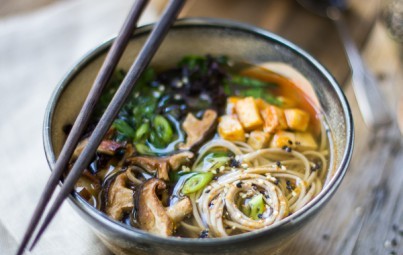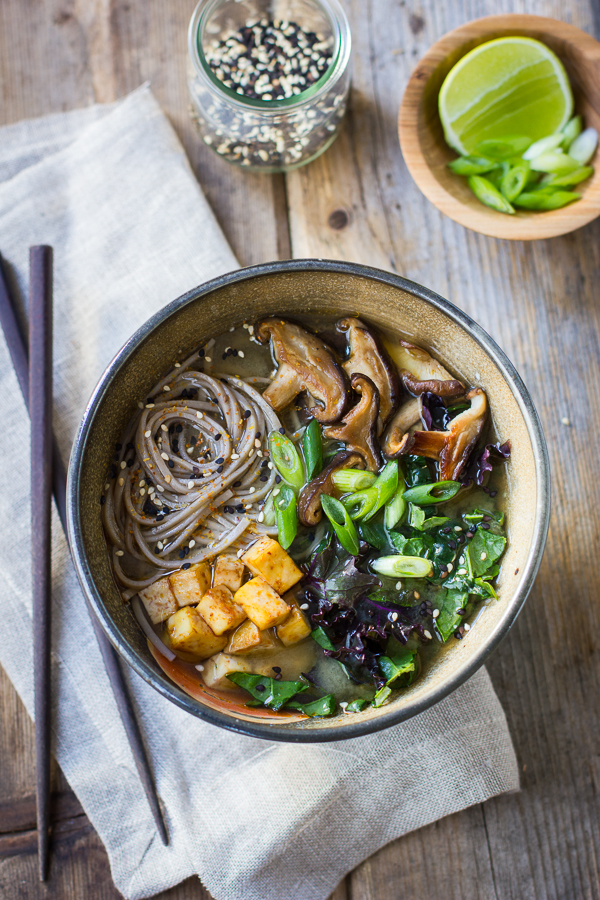Miso and Soba Noodle Soup with Roasted Sriracha Tofu and Shiitake Mushrooms
With inspiration from 101 Cookbooks and The Real Food Daily Cookbook. By Alanna Taylor-Tobin, originally published on The Bojon Gourmet. See the original post for step-by-step images.
Ever since living with a bunch of health nuts in Santa Cruz many years ago, I’ve held up miso soup as the pinnacle of wholesome meals. Fermented miso paste is full of good bacteria, brothy soups keep you sated longer, and, if you add whole grains, protein, and vegetables, it becomes a meal. My housemate Debra used to make the tastiest bowls of the stuff. When I moved to San Francisco, I decided to take a bit of Santa Cruz with me by instituting “Miso Mondays.” The idea was to start the week with a big bowl of soup for dinner in order to counteract the fact that I worked at a bakery where I spent the whole day cramming brownie pieces into my maw.FBut Miso Mondays lasted exactly one Monday. The reason? I couldn’t get miso soup to stop tasting like punishment. At its most basic, miso soup can be simply hot water stirred into miso paste and studded with cubes of tofu and a few rings of scallion. For a more substantial soup, I would try simmering vegetables in the broth, but the resulting pot always lacked the oomph I was looking for. I relegated miso soup to something I ate only when under the weather, and I got my miso fix in salads and pâtés, instead. But that all changed last week. Jay had a cold and I wanted to make him something light and brothy to sip on, so I decided to rethink miso soup. I borrowed the broth method from The Real Food Daily Cookbook. I borrowed the fixings from 101 Cookbooks, and I added some tweaks of my own. I decided to roast the tofu along with some shiitake mushrooms in a mixture of toasted sesame oil, tamari, and sriracha for the tofu. This gives them a bit of caramelization and a whole lot of flavor which does a lot to enhance the finished soup (assuming you can keep yourself from eating them all straight from the baking sheet). The “stock” is a simple infusion of kombu (a hefty type of seaweed), a few dried shiitake mushrooms, and several slices of ginger. This gets strained and whisked into a whole lot of miso paste. I usually use South River white or yellow miso; both have a salty-sweet flavor with a bit of funk from fermentation in wooden vessels. Miso can vary in saltiness, so I add tamari until the stock tastes just right, and a squeeze of lime to brighten the flavors. Cooking the soba noodles in salted water (contrary to the package directions) helps to give it a flavor boost, too. I wanted some dark, leafy greens in there, as well. Our co-op has been carrying “motly kale” – a pretty bouquet with several different varieties of leaves. Some are deep purple with ruffled leaves, some have spiky green leaves, and some are the lacinato variety that I usually spring for. To assemble the soup, a tangle of soba noodles goes into a large bowl (I use these handmade noodles by my über-talented friend, Amelia). The noodles are topped with the roasted tofu and shiitakes, the kale-y miso broth, and finished with thinly sliced scallion, sesame seeds, and togarashi, a Japanese chile powder. The noodles make the soup feel filling and a little decadent; plus it’s fun to slurp them from the brothy bowl. Noodles made from 100% buckwheat tend to fall apart more than the ones made with some wheat flour (pictured here), but they can be used for a gluten-free option. I’m pretty thrilled with this miso soba soup, but I can imagine all kinds of variations and additions, too: roasted sweet potato, kabocha squash, or cauliflower in the fall; fava beans, asparagus, peas or pea shoots in the spring; roasted summer squash or Japanese eggplant in the summer; edamame, hijiki or wakame anytime. Miso Mondays are suddenly sounding a little more fun.
Feel free to experiment here. Udon, ramen, or rice noodles can stand in for the soba. Noodles made entirely from buckwheat tend to be more fragile, but they make a flavorful gluten-free option nonetheless. Other seasonal vegetables can take the place of the kale and shiitakes. I usually use white or yellow miso, but feel free to experiment with different types. If not serving it all right away, store the components separately in the fridge until you’re ready to put it all together.
Makes 4 large bowls
- 2 inches ginger root, sliced into coins
- 4-6 (4″ square) sheets kombu
- 6 dried shiitake mushrooms
- 8 cups water
- 1/2 cup sweet white or yellow miso
- 2 tablespoons tamari (optional, depending on saltiness of miso)
- juice of 1 lime or lemon, to taste
- 8 ounces firm or extra-firm tofu, in 1/2″ cubes
- 8-12 ounces shiitake mushrooms, ends trimmed, sliced (about 6 cups)
- 3 tablespoons toasted sesame oil (divided use)
- 3 tablespoons tamari (divided use)
- 1 – 2 teaspoons Sriracha (depending on how spicy you like it)
- 12-16 ounces soba noodles (depending how noodley you like it)
- 1 bunch kale, stemmed and slivered
- 2 large or 3 small scallions, washed, trimmed, slivered
- toasted sesame seeds or gomashio (optional)
- togarashi (optional)
Divide the noodles among 4 large bowls. Add the shiitakes, tofu, and scallions. Pour the hot broth and kale over the fixings. Top with sesame seeds, gomashio, and/or togarashi, if you like.
Image courtesy of Alanna Taylor Tobin | The Bojon Gourmet
Alanna is a recovering pastry chef who loves sharing fresh, seasonal recipes from her San Francisco kitchen via her blog, The Bojon Gourmet (bojon = no job, backwards). Learn more about the Tao of Bojon here.




